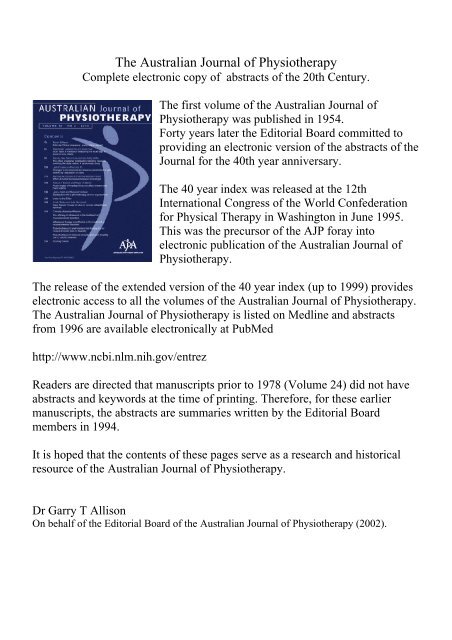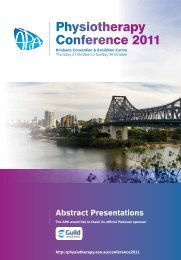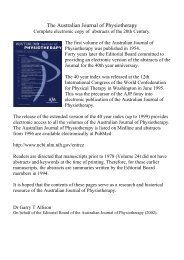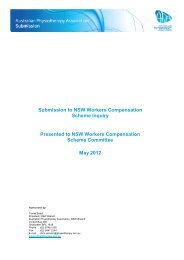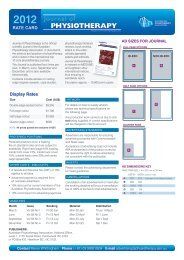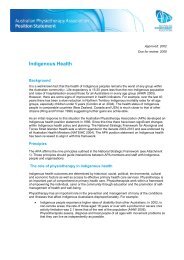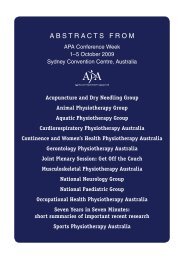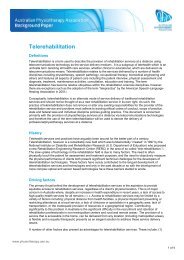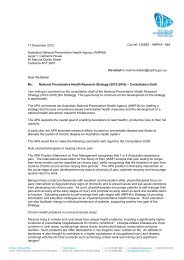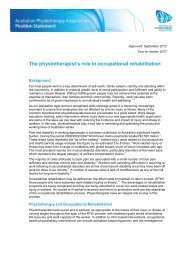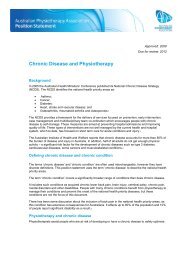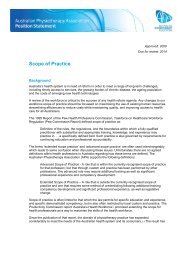The Australian Journal of Physiotherapy
The Australian Journal of Physiotherapy
The Australian Journal of Physiotherapy
Create successful ePaper yourself
Turn your PDF publications into a flip-book with our unique Google optimized e-Paper software.
<strong>The</strong> <strong>Australian</strong> <strong>Journal</strong> <strong>of</strong> <strong>Physiotherapy</strong><br />
Complete electronic copy <strong>of</strong> abstracts <strong>of</strong> the 20th Century.<br />
<strong>The</strong> first volume <strong>of</strong> the <strong>Australian</strong> <strong>Journal</strong> <strong>of</strong><br />
<strong>Physiotherapy</strong> was published in 1954.<br />
Forty years later the Editorial Board committed to<br />
providing an electronic version <strong>of</strong> the abstracts <strong>of</strong> the<br />
<strong>Journal</strong> for the 40th year anniversary.<br />
<strong>The</strong> 40 year index was released at the 12th<br />
International Congress <strong>of</strong> the World Confederation<br />
for Physical <strong>The</strong>rapy in Washington in June 1995.<br />
This was the precursor <strong>of</strong> the AJP foray into<br />
electronic publication <strong>of</strong> the <strong>Australian</strong> <strong>Journal</strong> <strong>of</strong><br />
<strong>Physiotherapy</strong>.<br />
<strong>The</strong> release <strong>of</strong> the extended version <strong>of</strong> the 40 year index (up to 1999) provides<br />
electronic access to all the volumes <strong>of</strong> the <strong>Australian</strong> <strong>Journal</strong> <strong>of</strong> <strong>Physiotherapy</strong>.<br />
<strong>The</strong> <strong>Australian</strong> <strong>Journal</strong> <strong>of</strong> <strong>Physiotherapy</strong> is listed on Medline and abstracts<br />
from 1996 are available electronically at PubMed<br />
http://www.ncbi.nlm.nih.gov/entrez<br />
Readers are directed that manuscripts prior to 1978 (Volume 24) did not have<br />
abstracts and keywords at the time <strong>of</strong> printing. <strong>The</strong>refore, for these earlier<br />
manuscripts, the abstracts are summaries written by the Editorial Board<br />
members in 1994.<br />
It is hoped that the contents <strong>of</strong> these pages serve as a research and historical<br />
resource <strong>of</strong> the <strong>Australian</strong> <strong>Journal</strong> <strong>of</strong> <strong>Physiotherapy</strong>.<br />
Dr Garry T Allison<br />
On behalf <strong>of</strong> the Editorial Board <strong>of</strong> the <strong>Australian</strong> <strong>Journal</strong> <strong>of</strong> <strong>Physiotherapy</strong> (2002).
Volume 1. 1954-1955<br />
May F (1954): <strong>The</strong> changing face <strong>of</strong> physical medicine. <strong>Australian</strong> <strong>Journal</strong> <strong>of</strong> <strong>Physiotherapy</strong> 1:<br />
6-10.<br />
<strong>The</strong> origin and evolution <strong>of</strong> the modalities used in physical medicine are described in this paper.<br />
Perspectives from the pr<strong>of</strong>essions <strong>of</strong> medicine and the importance <strong>of</strong> physical medicine in the<br />
restoration <strong>of</strong> health and its potential to improve the efficiency <strong>of</strong> service delivery in the health care<br />
system are highlighted.<br />
Keywords: History <strong>of</strong> Medicine; Physical Medicine; Physical <strong>The</strong>rapy<br />
Mackay J (1954): <strong>The</strong> physiotherapy <strong>of</strong> bronchiectasis. <strong>Australian</strong> <strong>Journal</strong> <strong>of</strong> <strong>Physiotherapy</strong> 1:<br />
10-14.<br />
This article documents the pathophysiology and classic features <strong>of</strong> bronchiectasis. <strong>Physiotherapy</strong><br />
management is discussed with particular reference to aspects <strong>of</strong> treatment including postural<br />
drainage, control <strong>of</strong> breathing, posture and relaxation. <strong>The</strong> importance <strong>of</strong> preventative treatment in<br />
the management <strong>of</strong> this disease is emphasised.<br />
Keywords: Bronchiectasis; Physical <strong>The</strong>rapy; Respiratory <strong>The</strong>rapy<br />
Blair HS and Swan RM (1954): Observations on the treatment <strong>of</strong> poliomyelitis in the United<br />
States <strong>of</strong> America. <strong>Australian</strong> <strong>Journal</strong> <strong>of</strong> <strong>Physiotherapy</strong> 1: 14-18.<br />
Treatment approaches for poliomyelitis employed at the Children's Medical Centre, Boston, and the<br />
Warm Springs Foundation, Georgia are discussed comparatively. Principles and methods <strong>of</strong><br />
treatment, stages <strong>of</strong> care and follow-up care plans are outlined for each <strong>of</strong> the facilities.<br />
<strong>Physiotherapy</strong> treatment methods examined include positioning, charting, stretching, muscle reeducation,<br />
hydrotherapy and functional training.<br />
Keywords: Physical therapy; Poliomyelitis; Rehabilitation<br />
Davis N (1954): Burns. <strong>Australian</strong> <strong>Journal</strong> <strong>of</strong> <strong>Physiotherapy</strong> 1: 18-21.<br />
An outline <strong>of</strong> the general principles <strong>of</strong> burns treatment is presented, including classification,<br />
pathology and surgical care. <strong>The</strong> role <strong>of</strong> the physiotherapist in treatment planning and the rationale<br />
for intervention is discussed, with particular consideration <strong>of</strong> the theoretical aspects <strong>of</strong> burns <strong>of</strong><br />
varying types and at various stages.<br />
Keywords: Burns; Physical <strong>The</strong>rapy; Surgery<br />
Murdoch AW (1954): Psychic factors in physiotherapy. <strong>Australian</strong> <strong>Journal</strong> <strong>of</strong> <strong>Physiotherapy</strong><br />
1: 22-24.<br />
This paper addresses the impact <strong>of</strong> psychogenic disorders and psychological components<br />
accompanying organic disorders in patients attending physiotherapy clinics. Patients are<br />
conceptualised as belonging to one <strong>of</strong> three subgroups, and those who attend therapy with a real<br />
need for emotional support and physical treatment are discussed. Specific attention is given to the
ethical approach <strong>of</strong> the treating physiotherapist to the point <strong>of</strong> treatment termination in patients with<br />
predominantly psychogenic symptoms.<br />
Keywords: Ethics; Physical <strong>The</strong>rapy; Psychophysiologic Disorders
1955<br />
Kingsley Norris F (1955): Over the hills and far away. <strong>Australian</strong> <strong>Journal</strong> <strong>of</strong> <strong>Physiotherapy</strong> 1:<br />
57-62.<br />
<strong>The</strong> origins and evolution <strong>of</strong> the physiotherapy pr<strong>of</strong>ession is presented, documenting the<br />
progression <strong>of</strong> the pr<strong>of</strong>ession from an art to a science within the context <strong>of</strong> the period, Christianity,<br />
and the Renaissance. Future directions and responsibilities <strong>of</strong> the pr<strong>of</strong>ession are discussed,<br />
addressing the key areas <strong>of</strong> teaching and research.<br />
Keywords: History <strong>of</strong> Medicine; Physical <strong>The</strong>rapy; Pr<strong>of</strong>essional Competence<br />
Keon-Cohen BT (1955): Backache with sciatica. <strong>Australian</strong> <strong>Journal</strong> <strong>of</strong> <strong>Physiotherapy</strong> 1: 62-67.<br />
Functional anatomy, pathology and clinical manifestations <strong>of</strong> backache with sciatica resulting from<br />
various lesions <strong>of</strong> the intervertebral discs are reviewed. <strong>The</strong> indications and outcomes <strong>of</strong> medical<br />
management, including manipulation, immobilisation and operation are described. Results<br />
following operative treatment by the author are recorded as good in 80 per cent <strong>of</strong> cases.<br />
<strong>Physiotherapy</strong> is reported to be required by few <strong>of</strong> the author's patients who have undergone<br />
surgery, as most rehabilitate themselves gradually.<br />
Keywords: Low Back Pain; Manipulative <strong>The</strong>rapy; Physical <strong>The</strong>rapy; Sciatica<br />
Kelley M (1955): Should arthritic patients become crippled? <strong>Australian</strong> <strong>Journal</strong> <strong>of</strong><br />
<strong>Physiotherapy</strong> 1: 69-76.<br />
This paper reviews recent advances in the field <strong>of</strong> rheumatology, and focuses on the primary goal <strong>of</strong><br />
treatment as the prevention <strong>of</strong> crippling. Treatment methods, with emphasis on the clinical benefits<br />
<strong>of</strong> hydrocortisone injections, and the immobilisation <strong>of</strong> joints to suppress inflammatory responses<br />
and prevent ankylosis are discussed. Particular attention is given to the regions <strong>of</strong> the upper limb<br />
and knee. <strong>The</strong> physiotherapist's primary role in these patients involves muscle training as a method<br />
<strong>of</strong> preventing deformities due to muscle weakness.<br />
Keywords: Arthritis; Physical <strong>The</strong>rapy; Arm; Knee Joint<br />
Coates A (1955): Handmaidens <strong>of</strong> healing: <strong>The</strong> history <strong>of</strong> surgery until the end <strong>of</strong> the<br />
eighteenth century. <strong>Australian</strong> <strong>Journal</strong> <strong>of</strong> <strong>Physiotherapy</strong> 1: 101-106.<br />
An account <strong>of</strong> the history <strong>of</strong> surgery is given from it's origins in Neolithic man <strong>of</strong> 300,000 BC<br />
through to the eighteenth century. From Egypt, where the first recorded operation on s<strong>of</strong>t tissues<br />
was performed, the evolution <strong>of</strong> surgery is traced through the Greco-Roman era, where the art was<br />
powerfully influenced by the physicians Hippocrates and Rhazes. <strong>The</strong> paper concludes with a<br />
discussion <strong>of</strong> the contributions <strong>of</strong> John Hunter, a surgeon in eighteenth century England, whose<br />
approach to disease and its treatment enabled diseases to be managed scientifically on a large scale.<br />
Keywords: History <strong>of</strong> Medicine; Physicians; Surgery<br />
Burgess TW (1955): Ultrasonic therapy. <strong>Australian</strong> <strong>Journal</strong> <strong>of</strong> <strong>Physiotherapy</strong> 1: 107-111.
<strong>The</strong> characteristics and biologic effects <strong>of</strong> ultrasound and general principles <strong>of</strong> application including<br />
indications and contraindications are reviewed. Clinical application <strong>of</strong> ultrasound therapy and its<br />
use in diagnosis and research are discussed. <strong>The</strong> clinical use <strong>of</strong> ultrasound predominantly focuses<br />
on the field <strong>of</strong> rheumatology, with treatment effects obtained including relief <strong>of</strong> pain, improvement<br />
<strong>of</strong> flexibility and a decrease in muscle spasm.<br />
Keywords: Physical <strong>The</strong>rapy; Rheumatology; Ultrasonic <strong>The</strong>rapy<br />
Lind P (1955): <strong>The</strong> treatment <strong>of</strong> spinal paraplegia at Stoke Mandeville. <strong>Australian</strong> <strong>Journal</strong> <strong>of</strong><br />
<strong>Physiotherapy</strong> 1: 112-117.<br />
This article outlines a new approach to rehabilitation <strong>of</strong> the spinal paraplegic patient adopted at the<br />
English National Spinal Unit. This approach encompassed all staff at the unit, and centred around<br />
the principle that apart from paralysis <strong>of</strong> the lower body, a person with paraplegia in most cases is<br />
otherwise fit and able to be trained to almost absolute independence. A description <strong>of</strong> both medical,<br />
nursing and physiotherapy interventions to facilitate independence is given, focusing on<br />
physiotherapy techniques used in functional re-education, the prevention <strong>of</strong> contractures and the<br />
reduction <strong>of</strong> spasticity.<br />
Keywords: Paraplegia; Physical <strong>The</strong>rapy; Rehabilitation<br />
Murray AR (1955): Peripheral nerve injuries and their treatment. <strong>Australian</strong> <strong>Journal</strong> <strong>of</strong><br />
<strong>Physiotherapy</strong> 1: 120-124.<br />
<strong>The</strong> author presents a detailed description <strong>of</strong> the structural aspects and functional significance <strong>of</strong><br />
peripheral nerve injuries. Diagnostic issues, possibility <strong>of</strong> recovery and rate <strong>of</strong> regrowth specific to<br />
each <strong>of</strong> the three types <strong>of</strong> nerve lesions are noted. Aims and methods <strong>of</strong> physiotherapy interventions<br />
are discussed, with particular attention to the use <strong>of</strong> massage, splinting, mobilisation and muscle reeducation<br />
as modalities to provide an optimum environment for recovery and to facilitate the<br />
integration <strong>of</strong> returned movement into normal functional patterns. <strong>The</strong> primary importance <strong>of</strong><br />
physiotherapy in the management <strong>of</strong> causalgia and phantom limb pain is reviewed.<br />
Keywords: Movement Dysfunction; Nerve Tissue Injuries; Physical <strong>The</strong>rapy<br />
Duigan C (1955): Relaxation and natural childbirth. <strong>Australian</strong> <strong>Journal</strong> <strong>of</strong> <strong>Physiotherapy</strong> 1:<br />
127-130.<br />
<strong>The</strong> role <strong>of</strong> physiotherapy in childbirth is described as one which enables the mother to remove fear,<br />
use energy efficiently and cope with pain and difficulties encountered during labour. Prenatal<br />
exercises, a description <strong>of</strong> labour and techniques used by the mother during labour are presented.<br />
<strong>The</strong> advantages <strong>of</strong> relaxation in childbirth are outlined.<br />
Keywords: Labor; Pain; Physical <strong>The</strong>rapy; Prenatal Care<br />
Wedlick LT (1955): Recent advances in medical electricity. <strong>Australian</strong> <strong>Journal</strong> <strong>of</strong><br />
<strong>Physiotherapy</strong> 1: 152-157.<br />
Recent developments in the field <strong>of</strong> medical electricity are described, along with their<br />
corresponding values and limitations. Microwave treatment, ultrasonics, electrical stimulation <strong>of</strong><br />
denervated muscle, electrical testing <strong>of</strong> nerve lesions and electrophrenic stimulation are covered.<br />
<strong>The</strong> author considers ultrasonic therapy to have a clear biologic effect, but is best kept in reserve
and used where other forms <strong>of</strong> physiotherapy fail. <strong>The</strong> modality <strong>of</strong> electrical stimulation has<br />
undergone the greatest advance in the last ten years, including elimination <strong>of</strong> the ionic effect during<br />
galvanic stimulation and more accurate current prescription. A detailed description <strong>of</strong> Intensity-<br />
Time curves for use as a supplement to the Galvanic-Faradic test is included.<br />
Keywords: Diathermy; Electric Stimulation <strong>The</strong>rapy; Physical <strong>The</strong>rapy; Ultrasonic <strong>The</strong>rapy<br />
Kerr DIB (1955): Proprioceptive reflexes. <strong>Australian</strong> <strong>Journal</strong> <strong>of</strong> <strong>Physiotherapy</strong> 1: 159-163.<br />
Advances in the knowledge <strong>of</strong> neuromuscular relationships have allowed a greater understanding <strong>of</strong><br />
muscle proprioception and its role in postural activity. <strong>The</strong> author discusses the fundamental<br />
physiological properties <strong>of</strong> reflexes, facilitation, inhibition, and excitation, conduction and response.<br />
<strong>The</strong>se principles are then applied to treatment approaches used in physiotherapy.<br />
Keywords: Neurophysiology; Physical <strong>The</strong>rapy; Posture; Proprioception<br />
Casely E (1955): <strong>Physiotherapy</strong> in South Australia. <strong>Australian</strong> <strong>Journal</strong> <strong>of</strong> <strong>Physiotherapy</strong> 1:<br />
164-169.<br />
<strong>The</strong> author follows the development <strong>of</strong> physiotherapy in South Australia spanning a period <strong>of</strong><br />
almost fifty years. <strong>The</strong> review documents among other achievements the opening <strong>of</strong> a<br />
physiotherapy department at the Royal Adelaide Hospital, the establishment <strong>of</strong> a Diploma <strong>of</strong><br />
<strong>Physiotherapy</strong> at the University <strong>of</strong> South Australia, the development <strong>of</strong> treatment for poliomyelitis<br />
in South Australia, and the passing <strong>of</strong> the Physiotherapists' act in 1945.<br />
Keywords: Physical <strong>The</strong>rapy; Poliomyelitis; Pr<strong>of</strong>essional Practice<br />
Curtis JB (1955): <strong>The</strong> nervous control <strong>of</strong> movement. <strong>Australian</strong> <strong>Journal</strong> <strong>of</strong> <strong>Physiotherapy</strong> 1:<br />
170-172.<br />
<strong>The</strong> author examines how traditional views <strong>of</strong> the control <strong>of</strong> movement may be modified in the<br />
context <strong>of</strong> recent advances in knowledge. <strong>The</strong> anatomical and physiological basis <strong>of</strong> the traditional<br />
theory is reviewed, and current concepts are presented and contrasted. It is concluded that the<br />
possible variations in the control <strong>of</strong> movement are far greater than the older more rigid concept<br />
allowed, and this perspective can be supported by observations during clinical practice.<br />
Keywords: Movement; Neuroanatomy; Neurophysiology<br />
Yule E (1955): <strong>Physiotherapy</strong> after tendon repair <strong>of</strong> the hand. <strong>Australian</strong> <strong>Journal</strong> <strong>of</strong><br />
<strong>Physiotherapy</strong> 1: 173-175.<br />
<strong>The</strong> aim <strong>of</strong> physiotherapy after tendon repair in the hand is normal relaxed action <strong>of</strong> the fingers to<br />
enable the patient to close or open their hand completely. This paper reviews current methods<br />
utilised in this area <strong>of</strong> rehabilitation. <strong>The</strong> author outlines a regime <strong>of</strong> splinting, active movements<br />
and movement re-education within a time scale to determine treatment progression.<br />
Keywords: Hand; Physical <strong>The</strong>rapy; Rehabilitation; Tendon Injuries<br />
Wing MN (1955): <strong>The</strong> role <strong>of</strong> physiotherapy in rehabilitation. <strong>Australian</strong> <strong>Journal</strong> <strong>of</strong><br />
<strong>Physiotherapy</strong> 1: 176-180.
<strong>The</strong> purpose <strong>of</strong> this article is to apply the description <strong>of</strong> the role <strong>of</strong> physiotherapy in rehabilitation to<br />
a wider field than has been previously conceptualised. <strong>The</strong> goal <strong>of</strong> rehabilitation is stated to be the<br />
restoration <strong>of</strong> the patient to a self-caring state, or as far as their condition will permit. This article<br />
analyses the role <strong>of</strong> the physiotherapist in accomplishing this goal, addressing the areas <strong>of</strong><br />
personality, qualifications, rehabilitation techniques, evaluation program, types <strong>of</strong> disabilities and<br />
the duties <strong>of</strong> the physiotherapist in team work. <strong>The</strong> author comments on the need to alter training<br />
approaches to allow students to accommodate the new regime.<br />
Keywords: Physical <strong>The</strong>rapy; Rehabilitation; Self Care (Rehabilitation)<br />
Farnbach M (1955): <strong>Physiotherapy</strong> for poliomyelitis patients in Victoria. <strong>Australian</strong> <strong>Journal</strong><br />
<strong>of</strong> <strong>Physiotherapy</strong> 1: 182-187.<br />
This article is a descriptive account <strong>of</strong> the method and organisation <strong>of</strong> physiotherapy intervention in<br />
poliomyelitis patients in Victoria. <strong>Physiotherapy</strong> services are commenced shortly after the onset <strong>of</strong><br />
disease consisting <strong>of</strong> active treatment and rest in splints. When possible patients are sent home to<br />
continue studies or other pursuits alongside treatment. Throughout the rehabilitation process<br />
patients are encouraged to be as independent as possible, and those with residual weakness are<br />
monitored regularly following rehabilitation.<br />
Keywords: Physical <strong>The</strong>rapy; Poliomyelitis; Rehabilitation<br />
McCutcheon A (1955): Progress in care <strong>of</strong> the aged. <strong>Australian</strong> <strong>Journal</strong> <strong>of</strong> <strong>Physiotherapy</strong> 1:<br />
188-192.<br />
<strong>The</strong> status <strong>of</strong> geriatric care in Australia is contrasted to that <strong>of</strong> the United Kingdom, observed by the<br />
author while attending the Third Congress <strong>of</strong> the International Association <strong>of</strong> Gerontology, London<br />
1954. <strong>The</strong> author participated in inspections <strong>of</strong> various rehabilitation centres for the aged as part <strong>of</strong><br />
the Congress, and the observations are recorded according to each facility visited. Care <strong>of</strong> the<br />
elderly is reported to be more advanced in the United Kingdom than Australia, and it is concluded<br />
that much work remains to be done if the standard <strong>of</strong> care in Australia is to be comparable to that<br />
overseas.<br />
Keywords: Aged; Medicine; Physical <strong>The</strong>rapy; Rehabilitation
Volume 2. 1956<br />
Gandevia B (1956): Research in <strong>Physiotherapy</strong>. <strong>Australian</strong> <strong>Journal</strong> <strong>of</strong> <strong>Physiotherapy</strong> 2: 5-19.<br />
Principles <strong>of</strong> clinical research work are addressed within the categories <strong>of</strong> the principles underlying<br />
the testing <strong>of</strong> methods <strong>of</strong> treatment, selection <strong>of</strong> a research project, and the posing <strong>of</strong> appropriate<br />
questions. Limitations <strong>of</strong> experiments, planning and administration <strong>of</strong> clinical trials, group<br />
comparability and assessment <strong>of</strong> progress are also discussed. <strong>The</strong> author has attempted to<br />
demonstrate that carefully planned clinical research work is able to be undertaken by an individual<br />
therapist or the staff <strong>of</strong> a department, and advocates this as a necessary process to assess treatment<br />
techniques and gain scientific credibility to further the pr<strong>of</strong>ession <strong>of</strong> physiotherapy.<br />
Keywords: Physical <strong>The</strong>rapy; Pr<strong>of</strong>essional Competence; Research<br />
Williams P (1956): Arthroplasty <strong>of</strong> the hip joint. <strong>Australian</strong> <strong>Journal</strong> <strong>of</strong> <strong>Physiotherapy</strong> 2: 21-25.<br />
A history <strong>of</strong> the development <strong>of</strong> techniques <strong>of</strong> hip arthroplasty, two methods currently used in<br />
Melbourne and the technique <strong>of</strong> pseudoarthrosis <strong>of</strong> the hip joint are described. Indications for<br />
operation, after-care, physiotherapy and expected progress are presented. It is concluded that<br />
although the surgical techniques <strong>of</strong> hip arthroplasty have not been perfected, the procedures hold<br />
value for those with crippling hip disease.<br />
Keywords: Arthroplasty; Hip Joint; Hip Prosthesis; Physical <strong>The</strong>rapy<br />
Gordon J (1956): Progressive muscular atrophies and dystrophies. <strong>Australian</strong> <strong>Journal</strong> <strong>of</strong><br />
<strong>Physiotherapy</strong> 2: 25-34.<br />
This article reviews the neurophysiology <strong>of</strong> peripheral motor neurones prior to classifying the<br />
various muscular diseases by dividing the common atrophies and dystrophies into clinical groups.<br />
<strong>The</strong> classifications include progressive muscular dystrophy, dystrophy combined with myotonus,<br />
neural progressive muscular atrophy, spinal progressive muscular atrophy and amyotonia congenita.<br />
Principle features, symptomatology, pathology and course are outlined for each <strong>of</strong> the diseases<br />
within each classification. <strong>The</strong> author acknowledges that there is still much to learn about this group<br />
<strong>of</strong> diseases, and until the aetiology is understood therapeutic measures which prevent, arrest or cure<br />
these diseases are unlikely to be developed.<br />
Keywords: Muscular Atrophy; Muscular Dystrophy; Neurophysiology; Peripheral Nerve<br />
Diseases<br />
Longmuir DO (1956): Principles and techniques in rehabilitation practice. <strong>Australian</strong> <strong>Journal</strong><br />
<strong>of</strong> <strong>Physiotherapy</strong> 2: 35-48.<br />
This paper deals with techniques and principles <strong>of</strong> proven value and common usage in many<br />
rehabilitation organisations, with emphasis on post-war work in the development <strong>of</strong> civilian<br />
rehabilitation services for the Commonwealth Government in Victoria. <strong>The</strong> success <strong>of</strong> rehabilitation<br />
is defined as the extent to which the remedial team can effectively pool their abilities and control<br />
their individuality in a concerted attack on the total problems <strong>of</strong> disablement. It is hoped that the<br />
services providing rehabilitation in the community will expand and place an increasing demand on<br />
the physiotherapy pr<strong>of</strong>ession for physiotherapists trained in the area.<br />
Keywords: Disabled; Physical <strong>The</strong>rapy; Rehabilitation
Bobath K and Bobath B (1956): Control <strong>of</strong> motor function in the treatment <strong>of</strong> cerebral palsy.<br />
<strong>Australian</strong> <strong>Journal</strong> <strong>of</strong> <strong>Physiotherapy</strong> 2: 75-85.<br />
This article discusses a neurophysiological treatment approach for cerebral palsy, arguing that the<br />
traditional methods <strong>of</strong> treatment formulated with an orthopaedic orientation are unsuitable for use in<br />
these patients with disordered motor function. <strong>The</strong> abnormal patterns <strong>of</strong> movement observed in<br />
patients with cerebral palsy are related to the release <strong>of</strong> reflex activity, and treatment techniques to<br />
overcome these influences and promote skilled movement are presented. <strong>The</strong> treatment approach<br />
centres around the inhibition <strong>of</strong> abnormal reflex activity and the facilitation <strong>of</strong> normal automatic<br />
movement patterns, and its theoretical background is proposed.<br />
Keywords: Cerebral Palsy; Movement Dysfunction; Physical <strong>The</strong>rapy<br />
West DR (1956): Movement education. <strong>Australian</strong> <strong>Journal</strong> <strong>of</strong> <strong>Physiotherapy</strong> 2: 85-89.<br />
<strong>The</strong> author describes her experiences in the teaching <strong>of</strong> physical education and the associated study<br />
<strong>of</strong> children's natural movements as forming the basis from which physical education teachers work.<br />
Qualities <strong>of</strong> movement are considered in terms <strong>of</strong> movement <strong>of</strong> the human structure. <strong>The</strong> much<br />
criticised lack <strong>of</strong> progression <strong>of</strong> this method <strong>of</strong> movement education is dismissed by the author as<br />
the child's growth is considered to be the yardstick <strong>of</strong> progression.<br />
Keywords: Child; Motor Skills; Movement; Physical Education and Training<br />
Abbie AA (1956): Nothing on the brain. <strong>Australian</strong> <strong>Journal</strong> <strong>of</strong> <strong>Physiotherapy</strong> 2: 90-94.<br />
A brief history <strong>of</strong> the evolution <strong>of</strong> man precedes an address <strong>of</strong> the functional aspects and<br />
comparative differences associated with the evolution and structure <strong>of</strong> the human brain. <strong>The</strong><br />
significance <strong>of</strong> the forebrain as the location for the seat <strong>of</strong> motor control and value <strong>of</strong> inhibitory<br />
mechanisms within this functioning are outlined. Emphasis is placed on the concept <strong>of</strong> 'nothing' as<br />
an active cerebral activity, a concept reinforced through evidence <strong>of</strong> areas <strong>of</strong> the brain set aside to<br />
ensure adequate inhibition.<br />
Keywords: Neural Inhibition; Neuroanatomy; Neurophysiology<br />
Dibden WA (1956): A two-year-old goes to hospital. <strong>Australian</strong> <strong>Journal</strong> <strong>of</strong> <strong>Physiotherapy</strong> 2:<br />
94-99.<br />
<strong>The</strong> issue <strong>of</strong> maternal deprivation is introduced with two brief case studies establishing the<br />
detrimental effect <strong>of</strong> prolonged separation <strong>of</strong> a child from it's mother. A film taken to document<br />
objective information on the behaviour <strong>of</strong> a child upon separation <strong>of</strong> it's mother is presented, and a<br />
synopsis given. Analysis <strong>of</strong> the film follows, highlighting the child's reactions both within and<br />
following the situation <strong>of</strong> separation from the mother.<br />
Keywords: Child Behavior; Child, Hospitalized; Maternal Deprivation<br />
Simpson D (1956): Residual disability after excision <strong>of</strong> brain tumours. <strong>Australian</strong> <strong>Journal</strong> <strong>of</strong><br />
<strong>Physiotherapy</strong> 2: 100-107.
This paper describes a study <strong>of</strong> the functional outcome <strong>of</strong> patients who have undergone<br />
neurosurgery for the excision <strong>of</strong> brain tumours. Two hundred and thirty-five patients with<br />
intracranial meningiomata underwent operative treatment between 1938 and 1953, and two hundred<br />
and five survived longer than six months postoperatively. <strong>The</strong> surviving patients as an unselected<br />
sample were traced, and an attempt was made to assess and grade their disabilities via personal<br />
interrogation, or more commonly by letters to either the patient or their doctor. <strong>The</strong> study utilises a<br />
scale <strong>of</strong> disability to classify work capacity. It was found that over a third <strong>of</strong> cases were classified as<br />
moderately, severely or totally disabled, translating to a disability range between returning to<br />
different work allowing for a definite limitation in their powers since operation, and total<br />
dependence. Discussion follows on the types <strong>of</strong> disability experienced, pathologic causes and<br />
location <strong>of</strong> the excised tumour.<br />
Keywords: Brain Neoplasms; Disabled; Outcome Assessment (health care)<br />
Kelley M (1956): Effects <strong>of</strong> muscular wasting in arthritis. <strong>Australian</strong> <strong>Journal</strong> <strong>of</strong> <strong>Physiotherapy</strong><br />
2: 136-141.<br />
Muscle imbalance in arthritic conditions is the primary cause <strong>of</strong> many deformities, and it's<br />
aetiology, effects and management are presented in this article. <strong>The</strong>se deformities can be prevented<br />
by muscle re-education, avoiding flexed positions, and splinting during periods <strong>of</strong> acute<br />
inflammation. <strong>The</strong> author stresses the importance <strong>of</strong> teaching patients to be their own<br />
physiotherapists in order to be on guard against the loss <strong>of</strong> muscle balance.<br />
Keywords: Arthritis; Exercise <strong>The</strong>rapy; Muscular Atrophy; Physical <strong>The</strong>rapy<br />
Kerr DIB (1956): <strong>The</strong> small motor fibre system <strong>of</strong> somatic muscle: Its physiological<br />
significance. <strong>Australian</strong> <strong>Journal</strong> <strong>of</strong> <strong>Physiotherapy</strong> 2: 141-146.<br />
Derangements <strong>of</strong> movement and posture occur in a variety <strong>of</strong> conditions treated by physiotherapists.<br />
In this article the author reviews the significance <strong>of</strong> understanding the basic mechanisms <strong>of</strong> posture<br />
and applying this knowledge scientifically in the formulation <strong>of</strong> treatment procedures. <strong>The</strong><br />
myostatic reflex and the role <strong>of</strong> the muscle spindle and its associated small motor fibre system are<br />
discussed in detail with respect to other modifying factors producing activation or inhibition <strong>of</strong> this<br />
system.<br />
Keywords: Movement Dysfunction; Neurophysiology; Physical <strong>The</strong>rapy; Posture<br />
Sims EB (1956): Developmental diagnosis in infancy. <strong>Australian</strong> <strong>Journal</strong> <strong>of</strong> <strong>Physiotherapy</strong> 2:<br />
147-149.<br />
Early diagnosis and treatment are important in the management <strong>of</strong> children with the various<br />
manifestations <strong>of</strong> cerebral palsy. This paper aims to cover the field <strong>of</strong> child development, with<br />
special reference to the acquisition <strong>of</strong> locomotor and manual skills. It is through intimate knowledge<br />
<strong>of</strong> infants at different ages that the subtle departures from the scheme <strong>of</strong> normal development can be<br />
detected by a physiotherapist and treatment prescribed if required. <strong>The</strong> locomotor and manual skill<br />
aspects <strong>of</strong> normal development are reviewed.<br />
Keywords: Cerebral Palsy; Infant; Movement; Physical <strong>The</strong>rapy;
Volume 3. 1957<br />
Burke BE (1957): Glossopharyngeal breathing and its use in the treatment <strong>of</strong> respiratory<br />
poliomyelitis patients, with some notes on chest respirators. <strong>Australian</strong> <strong>Journal</strong> <strong>of</strong><br />
<strong>Physiotherapy</strong> 3: 5-12.<br />
<strong>The</strong> history, technique and applications <strong>of</strong> glossopharyngeal breathing for independent ventilation<br />
in the presence <strong>of</strong> respiratory muscle paralysis are outlined with reference to respiratory<br />
poliomyelitis patients at Fairfield Hospital. Advantages, limitations, contraindications and teaching<br />
notes on the technique are presented. Comments are also included on the manufacture and use <strong>of</strong><br />
chest pieces, and these are compared with box respirators. Clinical experience has shown that a<br />
chest piece providing adequate ventilation allows a patient much more freedom than previously<br />
available with a box respirator.<br />
Keywords: Physical <strong>The</strong>rapy; Poliomyelitis; Respiratory <strong>The</strong>rapy; Ventilators<br />
Sutherland HD (1957): <strong>The</strong> development <strong>of</strong> thoracic surgery. <strong>Australian</strong> <strong>Journal</strong> <strong>of</strong><br />
<strong>Physiotherapy</strong> 3: 13-19.<br />
A history <strong>of</strong> thoracic surgery, including the discovery <strong>of</strong> the function <strong>of</strong> the lungs, the development<br />
<strong>of</strong> techniques to prevent lung collapse during intrathoracic surgery and the evolution <strong>of</strong> surgical<br />
techniques for various congenital and acquired conditions is recorded. <strong>The</strong> field <strong>of</strong> thoracic surgery<br />
is described by the author as a rapidly advancing field, requiring yearly overseas travel to remain<br />
abreast <strong>of</strong> developments in the field.<br />
Keywords: History <strong>of</strong> Medicine; Intraoperative Complications; Thoracic Surgery<br />
Ewing M (1957): <strong>The</strong> risk in taking to bed. <strong>Australian</strong> <strong>Journal</strong> <strong>of</strong> <strong>Physiotherapy</strong> 3: 19-25.<br />
<strong>The</strong> management <strong>of</strong> injury and disease almost always includes a period <strong>of</strong> rest in bed. <strong>The</strong><br />
numerous and diverse risks associated with bed rest are discussed in this paper, including the danger<br />
<strong>of</strong> falling out <strong>of</strong> bed and the psychological dimensions <strong>of</strong> bed rest. <strong>The</strong> life threatening development<br />
<strong>of</strong> venous thromboses, pulmonary complications and other affections reported to be significant<br />
factors in the cause <strong>of</strong> mortality following confinement to bed are reviewed.<br />
Keywords: Bed Rest; Disease; Mortality; Risk<br />
Burniston GG (1957): Rehabilitation. <strong>Australian</strong> <strong>Journal</strong> <strong>of</strong> <strong>Physiotherapy</strong> 3: 25-31.<br />
Principles <strong>of</strong> rehabilitation <strong>of</strong> the physically handicapped are discussed, and the relatively poor<br />
progress made in Australia towards providing rehabilitation services in this field compared with<br />
overseas countries is noted. <strong>The</strong> establishment <strong>of</strong> rehabilitation centres able to combine services<br />
addressing all <strong>of</strong> the factors contributing to a patient's handicap is viewed as a more effective<br />
method <strong>of</strong> delivering rehabilitation services.<br />
Keywords: Disabled; Health Services; Rehabilitation<br />
Wilson HC (1957): Electrical testing and treatment <strong>of</strong> nerve lesions. <strong>Australian</strong> <strong>Journal</strong> <strong>of</strong><br />
<strong>Physiotherapy</strong> 3: 51-55.
A brief historical account <strong>of</strong> electrical treatment for flaccid muscles is followed by an explanation<br />
<strong>of</strong> faradic-galvanic currents and their use in the testing and treatment <strong>of</strong> nerve lesions. Clinical<br />
application <strong>of</strong> the intensity-duration stimulator is illustrated, and examples <strong>of</strong> strength duration<br />
curves for normal, denervated and re-innervating muscle are analysed.<br />
Keywords: Electrodiagnosis; Electric Stimulation <strong>The</strong>rapy; Nerve Tissue Injury; Physical<br />
<strong>The</strong>rapy<br />
Hall GJ (1957): <strong>The</strong> management <strong>of</strong> a woman's emotional labour. <strong>Australian</strong> <strong>Journal</strong> <strong>of</strong><br />
<strong>Physiotherapy</strong> 3: 55-59.<br />
<strong>The</strong> management <strong>of</strong> a woman's emotions in labour is viewed by the author as being <strong>of</strong> vital<br />
importance to the successful outcome <strong>of</strong> the process. Assistance from outside the mother is usually<br />
required for a successful emotional labour. <strong>The</strong> margin for improvement in the management <strong>of</strong><br />
labour in Perth's obstetric hospitals is noted as associated with the lack <strong>of</strong> support given by obstetric<br />
staff. It is suggested that the physiotherapist occupies an ideal position to manage the physical and<br />
emotional aspects <strong>of</strong> normal labour, and components <strong>of</strong> this role are discussed.<br />
Keywords: Emotions; Labour; Outcome Assessment (health care); Physical <strong>The</strong>rapy<br />
Humphery RN (1957): Constipation and the digestive reflex. <strong>Australian</strong> <strong>Journal</strong> <strong>of</strong><br />
<strong>Physiotherapy</strong> 3: 59-62.<br />
This paper describes a treatment for the relief <strong>of</strong> constipation through the use <strong>of</strong> abdominal wall<br />
contractions to re-coordinate the digestive reflex. It is founded on the recognition <strong>of</strong> the alimentary<br />
tract as a reflex mechanism embracing all the organs <strong>of</strong> digestion, which becomes active in response<br />
to the stimulus <strong>of</strong> food placed in the mouth. <strong>The</strong> treatment rationale and method is discussed, with<br />
emphasis on the importance <strong>of</strong> timing in re-coordinating the digestive reflex and full and true<br />
muscle contractions <strong>of</strong> the abdominal wall.<br />
Keywords: Abdominal Muscles; Constipation; Digestive System; Physical <strong>The</strong>rapy;<br />
Rusk HA (1957): Rehabilitation <strong>of</strong> the hemiplegic patient. <strong>Australian</strong> <strong>Journal</strong> <strong>of</strong> <strong>Physiotherapy</strong><br />
3: 69-76.<br />
Both the physician and physiotherapist are challenged by the therapeutic complexities associated<br />
with hemiplegia. Many <strong>of</strong> these patients can be rehabilitated to a state <strong>of</strong> self-sufficiency. <strong>The</strong><br />
author reviews the evaluation <strong>of</strong> disabilities in hemiplegia, and describes objectives <strong>of</strong> the<br />
rehabilitation program and treatment procedures currently used.<br />
Keywords: Exercise <strong>The</strong>rapy; Hemiplegia; Physical <strong>The</strong>rapy; Rehabilitation<br />
Hembrow CH (1957): <strong>The</strong> role <strong>of</strong> physiotherapy in orthopaedic surgery. <strong>Australian</strong> <strong>Journal</strong> <strong>of</strong><br />
<strong>Physiotherapy</strong> 3: 77-86.<br />
<strong>The</strong> author reviews the foundations <strong>of</strong> orthopaedics. This encompasses concepts relevant to<br />
physiotherapists in the areas <strong>of</strong> normal growth and development <strong>of</strong> children, kinesiology, normal<br />
body mechanics and posture, and the pathology <strong>of</strong> injury. Treatment methods applied by<br />
physiotherapists in orthopaedics are discussed. Success in treatment is viewed as the understanding<br />
<strong>of</strong> each orthopaedic case, and physiotherapists are advised to avoid adopting a routine system <strong>of</strong><br />
treatment.
Keywords: Orthopedics; Pediatrics; Physical <strong>The</strong>rapy<br />
Campbell AH (1957): <strong>The</strong> nature <strong>of</strong> dyspnoea and its management by physiotherapy.<br />
<strong>Australian</strong> <strong>Journal</strong> <strong>of</strong> <strong>Physiotherapy</strong> 3: 87-91.<br />
This paper analyses the nature <strong>of</strong> dyspnoea in terms <strong>of</strong> its physiology and pathology, and examines<br />
the use <strong>of</strong> breathing exercises in the light <strong>of</strong> this analysis. Breathing exercises are designed to<br />
eliminate wasteful or uncoordinated movements, and on achievement <strong>of</strong> which the respiratory effort<br />
is likely to be reduced and the degree <strong>of</strong> dyspnoea lessened.<br />
Keywords: Dyspnea; Physical <strong>The</strong>rapy; Respiratory <strong>The</strong>rapy<br />
Drew JF and Gilmour IH (1957): Moist heat in rheumatic disease: <strong>The</strong> wax bath. <strong>Australian</strong><br />
<strong>Journal</strong> <strong>of</strong> <strong>Physiotherapy</strong> 3: 91-96.<br />
<strong>The</strong> modality <strong>of</strong> heat, its mode <strong>of</strong> action and value in relieving the symptoms <strong>of</strong> pain and stiffness<br />
in rheumatic disease is presented. <strong>The</strong> wax bath is discussed as a technique <strong>of</strong> applying a moist heat<br />
treatment, and detailed instructions for the construction <strong>of</strong> a wax bath are recorded.<br />
Keywords: Heat; Physical <strong>The</strong>rapy; Rheumatology<br />
McCloskey GG and Casanelia M (1957): <strong>Physiotherapy</strong> and the orthopaedic patient.<br />
<strong>Australian</strong> <strong>Journal</strong> <strong>of</strong> <strong>Physiotherapy</strong> 3: 97-101.<br />
This paper documents three case studies illustrating the importance <strong>of</strong> physiotherapy in the<br />
management <strong>of</strong> orthopaedic patients. <strong>The</strong> diagnoses include meniscectomy, chronic non-specific<br />
infective arthritis, osteoarthritis <strong>of</strong> the ankle joint with persistent subluxation and decalcification<br />
characteristic <strong>of</strong> Sudeck's atrophy, and intervertebral disc degeneration.<br />
Keywords: Arthritis; Orthopedics; Physical <strong>The</strong>rapy;<br />
Peszczynski M (1957): Trends in the rehabilitation <strong>of</strong> the long-term ill and severely disabled.<br />
<strong>Australian</strong> <strong>Journal</strong> <strong>of</strong> <strong>Physiotherapy</strong> 3: 129-135.<br />
<strong>The</strong>re is a growing interest in the comparatively new areas <strong>of</strong> physical medicine and rehabilitation<br />
from physicians and other related specialities. A recent history is given <strong>of</strong> rehabilitation <strong>of</strong> the longterm-ill,<br />
and the development <strong>of</strong> Highland View Hospital as an institution that places great<br />
emphasis upon rehabilitation. Staffing, patient diagnostic categories, teaching and research<br />
activities at the hospital are reported. Continuing changes in the medical and allied health<br />
pr<strong>of</strong>essions in this field are likely to enable an adequate service to be provided to the long-term-ill<br />
and relieve the economic burden on society.<br />
Keywords: Disabled; Physical <strong>The</strong>rapy; Rehabilitation<br />
Maitland GD (1957): Manipulation technique for the lower back. <strong>Australian</strong> <strong>Journal</strong> <strong>of</strong><br />
<strong>Physiotherapy</strong> 3: 135-140.<br />
<strong>The</strong> principles <strong>of</strong> treatment, examination and treatment techniques <strong>of</strong> the lumbar spine using<br />
manipulation are discussed. <strong>The</strong> importance <strong>of</strong> continual assessment <strong>of</strong> the patient's condition is<br />
emphasised. Excellent results following the use <strong>of</strong> these manipulation techniques are reported.
Keywords: Low Back Pain; Manipulative <strong>The</strong>rapy; Physical <strong>The</strong>rapy<br />
Finney ES (1957): Mitral valvotomy for physiotherapists. <strong>Australian</strong> <strong>Journal</strong> <strong>of</strong> <strong>Physiotherapy</strong><br />
3: 141-147.<br />
This paper presents an overall picture <strong>of</strong> the preoperative and postoperative condition and<br />
management <strong>of</strong> patients undergoing mitral valvotomy from a physiotherapy perspective. <strong>The</strong><br />
anatomy, pathology, preoperative assessment, postoperative assessment, postoperative management<br />
and possible complications are discussed. In conclusion the importance <strong>of</strong> careful patient handling,<br />
prevention <strong>of</strong> fatigue and maintenance <strong>of</strong> efficient circulation in the lower limbs is stressed.<br />
Keywords: Heart Surgery; Physical <strong>The</strong>rapy; Postoperative Care; Postoperative<br />
Complications<br />
Gale AF and Hueston JT (1957): Muscle training for biceps cineplasty. <strong>Australian</strong> <strong>Journal</strong> <strong>of</strong><br />
<strong>Physiotherapy</strong> 3: 148-151.<br />
Early conclusions about the training <strong>of</strong> biceps cineplasty at the Repatriation General Hospital,<br />
Victoria are recorded. <strong>The</strong> general principles <strong>of</strong> cineplasty training, preparation for operation,<br />
postoperative care and muscle motor training are covered for patients undergoing unilateral or<br />
bilateral forearm amputation. Although the need for improvement in the design <strong>of</strong> mechanical hands<br />
is acknowledged, the technique described is allowing patients to resume their previous occupations.<br />
Keywords: Exercise <strong>The</strong>rapy; Muscle; Physical <strong>The</strong>rapy; Rehabilitation<br />
Usher EC (1957): Speech therapy. <strong>Australian</strong> <strong>Journal</strong> <strong>of</strong> <strong>Physiotherapy</strong> 3: 152-155.<br />
<strong>The</strong> general qualifications, training, and scope <strong>of</strong> the work <strong>of</strong> speech therapists in Australia, and<br />
their approach to the common problem <strong>of</strong> aphasia is discussed. <strong>The</strong> definition, aetiology, prognosis,<br />
and aims <strong>of</strong> treatment for aphasia are outlined with reference to integration with other health<br />
pr<strong>of</strong>essionals in a rehabilitation setting.<br />
Keywords: Aphasia; Speech <strong>The</strong>rapy; Rehabilitation<br />
White J (1957): Psychology. <strong>Australian</strong> <strong>Journal</strong> <strong>of</strong> <strong>Physiotherapy</strong> 3: 155-160.<br />
A general overview <strong>of</strong> psychology, the clinical psychologist, and observations on aspects <strong>of</strong><br />
psychological research <strong>of</strong> interest to physiotherapists are recorded. <strong>The</strong> inclusion <strong>of</strong> aspects <strong>of</strong><br />
psychology directly related to physiotherapists within their training is recommended, and this is<br />
supported by discussion <strong>of</strong> the use <strong>of</strong> psychology in the practice <strong>of</strong> physiotherapy. In summary, the<br />
author advocates a multi-disciplinary approach to patient care involving the unified participation <strong>of</strong><br />
all specialities.<br />
Keywords: Physical <strong>The</strong>rapy; Psychology; Rehabilitation<br />
Cullen DM (1957): A realistic approach to physiotherapy in the postnatal period. <strong>Australian</strong><br />
<strong>Journal</strong> <strong>of</strong> <strong>Physiotherapy</strong> 3: 184-187.<br />
This article stresses the primary importance <strong>of</strong> restoring the abdominal and pelvic floor muscles<br />
after normal parturition, and the early instillation <strong>of</strong> a sense <strong>of</strong> correct posture. An exercise program
trialed on seventy-four patients is outlined, and the rationale and proposed advantages over the<br />
previous standard approach discussed.<br />
Keywords: Exercise <strong>The</strong>rapy; Physical <strong>The</strong>rapy; Postnatal Care; Posture
Volume 4. 1958<br />
Ross M, Gandevia B and Bolton JH (1958): <strong>The</strong> rationale, methods and results <strong>of</strong><br />
physiotherapy for asthma. <strong>Australian</strong> <strong>Journal</strong> <strong>of</strong> <strong>Physiotherapy</strong> 4: 11-18.<br />
<strong>The</strong> mechanism <strong>of</strong> respiration in asthma and it's significance in physiotherapy is discussed. A<br />
physiotherapeutic regimen for asthma is described which incorporates modification <strong>of</strong> breathing<br />
exercises commonly employed. <strong>The</strong> emphasis on expiration is removed, and attention is focussed<br />
solely on inspiration primarily using the diaphragm. <strong>The</strong>se two exercise regimens were examined in<br />
a controlled clinical trial. A summary <strong>of</strong> the results suggest the new modified technique produces a<br />
superior outcome.<br />
Keywords: Asthma; Physical <strong>The</strong>rapy; Respiratory <strong>The</strong>rapy<br />
Casely E (1958): Atherosclerosis obliterans. <strong>Australian</strong> <strong>Journal</strong> <strong>of</strong> <strong>Physiotherapy</strong> 4: 19-22.<br />
<strong>The</strong> pathology, symptoms, signs and prognosis <strong>of</strong> atherosclerosis obliterans are reviewed. From the<br />
physiotherapeutic point <strong>of</strong> view, treatment is directed towards improving blood flow and decreasing<br />
the disparity between the demand for blood and its supply. Methods used to increase blood flow are<br />
discussed in detail. Particular emphasis is given to the importance <strong>of</strong> walking. <strong>The</strong> author expresses<br />
the hope that this paper will stimulate wider interest in the condition and more detailed care in the<br />
early stages <strong>of</strong> the disease.<br />
Keywords: Atherosclerosis; Physical <strong>The</strong>rapy; Walking<br />
Maitland GD (1958): Migraine. <strong>Australian</strong> <strong>Journal</strong> <strong>of</strong> <strong>Physiotherapy</strong> 4: 23-25.<br />
This article describes current views on the possible causes and clinical features <strong>of</strong> migraine.<br />
Successful treatment <strong>of</strong> these symptoms by traction and manipulation is demonstrated through a<br />
case report. <strong>The</strong> author remarks in conclusion that some patients with migraine, or symptoms<br />
closely resembling migraine, may actually be suffering from a condition <strong>of</strong> cervical origin which<br />
can be relieved or prevented by appropriate manipulation.<br />
Keywords: Manipulative <strong>The</strong>rapy; Migraine; Physical <strong>The</strong>rapy<br />
Scott NH (1958): Pool therapy. <strong>Australian</strong> <strong>Journal</strong> <strong>of</strong> <strong>Physiotherapy</strong> 4: 25-28.<br />
This article records the author's experience with pool therapy, and outlines the rationale, techniques<br />
and results gained through this form <strong>of</strong> therapy at Harlow Wood Orthopaedic Hospital,<br />
Nottinghamshire.<br />
Keywords: Hydrotherapy; Physical <strong>The</strong>rapy; Rehabilitation<br />
Barrett J (1958): <strong>The</strong> importance <strong>of</strong> massage. <strong>Australian</strong> <strong>Journal</strong> <strong>of</strong> <strong>Physiotherapy</strong> 4: 28-31.<br />
This article promotes the value <strong>of</strong> deep massage as valuable in treating many musculoskeletal<br />
disorders. <strong>The</strong> use <strong>of</strong> penetrating heat followed by deep massage is suggested as a method for<br />
increasing the benefits gained by active exercises. <strong>The</strong> application and use <strong>of</strong> deep massage is<br />
described for stiff shoulders, stiff and strained knees, stiff ankles, low back strains and spasm in the<br />
upper part <strong>of</strong> the trapezius muscle.
Keywords: Massage; Musculoskeletal Diseases; Physical <strong>The</strong>rapy
Wedlick LT (1958): <strong>The</strong> physical medicine department in hospital service. <strong>Australian</strong> <strong>Journal</strong><br />
<strong>of</strong> <strong>Physiotherapy</strong> 4: 58-61.<br />
Through perspectives gained from a recent overseas tour, the author believes physical medicine<br />
departments in Australia are beginning to fall behind those overseas. <strong>The</strong> author claims the areas <strong>of</strong><br />
staffing, equipment and space are in need <strong>of</strong> expansion, and the rehabilitation centres and therapists<br />
operating in these should be under the direct medical supervision <strong>of</strong> a specialist in the area.<br />
Keywords: Consultants; Physical Medicine; Physical <strong>The</strong>rapy Department, hospital<br />
Simpson JA (1958): <strong>The</strong> development <strong>of</strong> thoracic and cardiac surgery. <strong>Australian</strong> <strong>Journal</strong> <strong>of</strong><br />
<strong>Physiotherapy</strong> 4: 82-85.<br />
<strong>The</strong> history <strong>of</strong> thoracic surgery is followed from the Hippocratic era to the present time. This review<br />
identifies a period <strong>of</strong> rapid advances in the second half <strong>of</strong> the nineteenth century when antiseptic<br />
surgery and general anaesthesia were discovered. Factors contributing to the delay in the progress<br />
<strong>of</strong> thoracic surgery are identified.<br />
Keywords: Anasthesia, general; Anti-infective Agents; History <strong>of</strong> Medicine; Thoracic Surgery<br />
Bedbrook GM (1958): <strong>The</strong> management <strong>of</strong> the acute spinal cord injury. <strong>Australian</strong> <strong>Journal</strong> <strong>of</strong><br />
<strong>Physiotherapy</strong> 4: 86-92.<br />
This article documents the establishment, treatment approach and outcomes <strong>of</strong> the Paraplegic Unit<br />
at Royal Perth Hospital. Aspects <strong>of</strong> care within the unit, including clinical assessment, surgical<br />
management, nursing management, physiotherapy, dietetic treatment, occupational therapy, and<br />
social management are described. <strong>The</strong> results achieved by the unit, although not yet up to world<br />
standards, indicate the future for these patients will be more promising than in the past.<br />
Keywords: Paraplegia; Physical <strong>The</strong>rapy; Rehabilitation<br />
Forster A (1958): Planning an exercise program for a patient with a chronic nervous disease.<br />
<strong>Australian</strong> <strong>Journal</strong> <strong>of</strong> <strong>Physiotherapy</strong> 4: 92-94.<br />
If the approach <strong>of</strong> physiotherapy in patients with chronic nervous disease is to be worthwhile the<br />
author believes it must be carefully planned and focused on gains in functional activity that improve<br />
a patient's independence. Methods <strong>of</strong> treatment planning in these patients are presented that<br />
encompass individual treatments, independent activities performed by the patient and group<br />
activities.<br />
Keywords: Exercise <strong>The</strong>rapy; Neuromuscular Diseases; Physical <strong>The</strong>rapy;<br />
Lewis CWD (1958): Pain in the upper limb. <strong>Australian</strong> <strong>Journal</strong> <strong>of</strong> <strong>Physiotherapy</strong> 4: 95-97.<br />
<strong>The</strong> main causes <strong>of</strong> pain in the upper limb are reviewed, and a few <strong>of</strong> the more common causes are<br />
analysed in detail. <strong>The</strong>se include the scalene syndrome, ulnar neuritis, and carpal tunnel syndrome.<br />
<strong>Physiotherapy</strong> has an important role in the rehabilitation <strong>of</strong> these conditions that is independent <strong>of</strong><br />
the need for surgery.<br />
Keywords: Arm; Pain; Physical <strong>The</strong>rapy; Rehabilitation
Lawes CHW (1958): Gravitational ulcers. <strong>Australian</strong> <strong>Journal</strong> <strong>of</strong> <strong>Physiotherapy</strong> 4: 97-100.<br />
<strong>The</strong> anatomy, physiology, pathology, clinical features and treatment <strong>of</strong> gravitational ulcers is<br />
presented. It is caused by defects in venous return <strong>of</strong> the limb, and keystones <strong>of</strong> treatment are rest,<br />
elevation, massage and firm elastic support. <strong>Physiotherapy</strong> plays an important role in the treatment<br />
<strong>of</strong> this condition, and this is briefly described.<br />
Keywords: Massage; Physical <strong>The</strong>rapy; Ulcer<br />
Wilson HC (1958): Facial paralysis. <strong>Australian</strong> <strong>Journal</strong> <strong>of</strong> <strong>Physiotherapy</strong> 4: 121-123.<br />
<strong>The</strong> anatomy <strong>of</strong> the facial nerve is reviewed and the various lesions which may involve it outlined.<br />
<strong>The</strong> treatment <strong>of</strong> facial paralysis is described with particular reference to the importance <strong>of</strong> early<br />
and effective splinting and the role <strong>of</strong> electrical stimulation.<br />
Keywords: Electrical Stimulation <strong>The</strong>rapy; Facial Paralysis; Physical <strong>The</strong>rapy<br />
Saint EG (1958): Education for the future. <strong>Australian</strong> <strong>Journal</strong> <strong>of</strong> <strong>Physiotherapy</strong> 4: 129-139.<br />
This article reviews objectives and education in relation to physiotherapy in its current clinical and<br />
social setting. <strong>The</strong> recent history <strong>of</strong> physiotherapy is reviewed. Present educational philosophies and<br />
organisational structure among the health care pr<strong>of</strong>essions are challenged for their concern with<br />
prestige and failure to promote an essential collaborative atmosphere between the pr<strong>of</strong>essions. <strong>The</strong><br />
author views all vocational and pr<strong>of</strong>essional life as a form <strong>of</strong> social activity intimately related to<br />
community needs. In conclusion, a desire is expressed for inspired education in the schools, and<br />
social awareness to enlighten pr<strong>of</strong>essional endeavours.<br />
Keywords: Education; History <strong>of</strong> Medicine; Physical <strong>The</strong>rapy;<br />
McComb H (1958): <strong>The</strong> care <strong>of</strong> the injured hand. <strong>Australian</strong> <strong>Journal</strong> <strong>of</strong> <strong>Physiotherapy</strong> 4: 138-<br />
146.<br />
<strong>The</strong> assessment <strong>of</strong> hand injuries is discussed with particular reference to the difference between tidy<br />
and untidy injuries. Diagnosis <strong>of</strong> tendon and nerve lacerations, and the management <strong>of</strong> these<br />
conditions is described in detail. <strong>The</strong> management <strong>of</strong> associated fractures and procedures available<br />
for the replacement <strong>of</strong> skin loss are discussed. Postoperative problems and causes <strong>of</strong> unsatisfactory<br />
results are outlined, and the role <strong>of</strong> physiotherapy at each stage is indicated.<br />
Keywords: Hand Injuries; Physical <strong>The</strong>rapy; Postoperative Care; Tendon Injuries<br />
Lekias JS (1958): Some aspects <strong>of</strong> neurosurgery in relation to physiotherapy. <strong>Australian</strong><br />
<strong>Journal</strong> <strong>of</strong> <strong>Physiotherapy</strong> 4: 146-150.<br />
<strong>Physiotherapy</strong> in neurosurgical patients is particularly concerned with the maintenance <strong>of</strong> muscle<br />
bulk, the preservation <strong>of</strong> joint mobility, re-education <strong>of</strong> limb muscles and rehabilitation. Similar<br />
principles apply whether muscular activity is impaired because <strong>of</strong> paresis, spasticity or loss <strong>of</strong><br />
effective control. This concept is illustrated in this article by a consideration <strong>of</strong> traumatic and<br />
acquired lesions <strong>of</strong> the peripheral nerves, spinal cord and brain during the acute and recovery<br />
phases.<br />
Keywords: Neurosurgery; Physical <strong>The</strong>rapy; Rehabilitation
Sinclair DC (1958): <strong>The</strong> anatomy <strong>of</strong> pain. <strong>Australian</strong> <strong>Journal</strong> <strong>of</strong> <strong>Physiotherapy</strong> 4: 150-155.<br />
<strong>The</strong> author views the present state <strong>of</strong> knowledge <strong>of</strong> the anatomy <strong>of</strong> pain as clearly unsatisfactory.<br />
<strong>The</strong> nerve endings, nerve fibres, sensory pathways and central terminations concerned with pain are<br />
described. It is believed that the anatomist has not much to discover in future investigations <strong>of</strong> the<br />
peripheral nervous system, although there is still much to be learned in the central nervous system<br />
concerning the problems <strong>of</strong> pain. It is suggested these may be best investigated by a team <strong>of</strong><br />
scientists from multiple disciplines.<br />
Keywords: Pain; Peripheral Nerves; Neuroanatomy<br />
Goatcher P (1958): Rheumatoid arthritis. <strong>Australian</strong> <strong>Journal</strong> <strong>of</strong> <strong>Physiotherapy</strong> 4: 156-162.<br />
This paper outlines current concepts <strong>of</strong> the aetiology, diagnosis and management <strong>of</strong> rheumatoid<br />
arthritis. <strong>The</strong> role <strong>of</strong> the physiotherapist is viewed as one that addresses the local treatment <strong>of</strong><br />
inflamed joints and as an important element in the management <strong>of</strong> the patient as a whole. <strong>The</strong><br />
unsatisfactory state <strong>of</strong> facilities for rehabilitation available at present is noted.<br />
Keywords: Arthritis, rheumatoid; Physical <strong>The</strong>rapy; Rehabilitation<br />
CB (1958): Emphysema and bronchitis. <strong>Australian</strong> <strong>Journal</strong> <strong>of</strong> <strong>Physiotherapy</strong> 4: 162-166.<br />
<strong>The</strong> mechanism and control <strong>of</strong> respiration is outlined, and the effectiveness <strong>of</strong> physiotherapy in<br />
disorders involving respiration is attributed to voluntary control over this process. <strong>The</strong> pathology,<br />
aetiology, clinical picture and treatment regimen for emphysema and bronchitis are discussed.<br />
Results observed through implementation <strong>of</strong> the treatment regimen indicate the majority <strong>of</strong> patients<br />
report subjective improvement in dyspnoea, and increases in the maximum breathing capacity <strong>of</strong><br />
patients was measured. It is concluded that the effectiveness <strong>of</strong> treatment is possibly strongly<br />
related to the enthusiasm <strong>of</strong> the staff.<br />
Keywords: Bronchitis; Emphysema; Physical <strong>The</strong>rapy; Respiratory <strong>The</strong>rapy<br />
Davis E (1958): Hemiplegia in the adult. <strong>Australian</strong> <strong>Journal</strong> <strong>of</strong> <strong>Physiotherapy</strong> 4: 187-189.<br />
<strong>The</strong> clinical problem <strong>of</strong> hemiplegia is discussed with particular reference to its frequency and<br />
pathogenesis. Clinical features <strong>of</strong> hemiplegia are briefly outlined and the principles and aims <strong>of</strong><br />
treatment are defined.<br />
Keywords: Hemiplegia; Physical <strong>The</strong>rapy; Rehabilitation
Volume 5. 1959<br />
Burnell AW (1959): Why physical medicine? <strong>Australian</strong> <strong>Journal</strong> <strong>of</strong> <strong>Physiotherapy</strong> 5: 5-9.<br />
This paper reviews the current situation <strong>of</strong> physical medicine in Australia compared with that <strong>of</strong><br />
overseas nations, and discusses the effects <strong>of</strong> its presence on physiotherapy. <strong>The</strong> functions <strong>of</strong> the<br />
specialist in physical medicine are described, and include the provision <strong>of</strong> an accurate diagnosis and<br />
plan <strong>of</strong> treatment, the improvement <strong>of</strong> the status <strong>of</strong> physiotherapy and integration <strong>of</strong> the<br />
rehabilitation team. <strong>The</strong> author describes the operation <strong>of</strong> a physical medicine department in<br />
England, and the role <strong>of</strong> the physiotherapist within this structure. It is concluded that a physical<br />
medicine department has more to <strong>of</strong>fer than a physiotherapy department.<br />
Keywords: Consultant; Physical Medicine; Physical <strong>The</strong>rapy; Rehabilitation Centres<br />
Hobson EPG (1959): Recent trends in physiotherapy in the United Kingdom. <strong>Australian</strong> <strong>Journal</strong> <strong>of</strong><br />
<strong>Physiotherapy</strong> 5: 10-13.<br />
An impression <strong>of</strong> the current status <strong>of</strong> physiotherapy in the United Kingdom is presented by the<br />
Superintendent Physical <strong>The</strong>rapist at King's College Hospital, London. A description is given <strong>of</strong> the<br />
impact <strong>of</strong> new therapeutic methods in physiotherapy, and the functioning <strong>of</strong> the physiotherapy<br />
department under the direction <strong>of</strong> a consultant in physical medicine. Also discussed are the new<br />
trends in remedial exercises, team work in management, and resettlement clinics held at the<br />
hospital. <strong>The</strong> author concludes by emphasising the need for physiotherapy to keep pace with the<br />
present needs <strong>of</strong> society.<br />
Keywords: Consultant; Physical Medicine; Physical <strong>The</strong>rapy; Physical <strong>The</strong>rapy Department,<br />
hospital;<br />
Maitland GD (1959): <strong>The</strong> treatment <strong>of</strong> lesions in the cervical region by manipulation.<br />
<strong>Australian</strong> <strong>Journal</strong> <strong>of</strong> <strong>Physiotherapy</strong> 5: 41-46.<br />
Relevant points in the history and examination <strong>of</strong> a patient with a suspected lesion <strong>of</strong> the cervical<br />
spine are discussed. Both direct and indirect techniques <strong>of</strong> manipulation in this region and their<br />
indications are described. <strong>The</strong> treatment approach is illustrated through the presentation <strong>of</strong> four case<br />
histories.<br />
Keywords: Cervical Vertebrae; Manipulative <strong>The</strong>rapy; Neck; Physical <strong>The</strong>rapy;<br />
Paige MJ (1959): Manipulation in the management <strong>of</strong> the first lumbar root syndrome.<br />
<strong>Australian</strong> <strong>Journal</strong> <strong>of</strong> <strong>Physiotherapy</strong> 5: 47-50.<br />
<strong>The</strong> anatomy <strong>of</strong> the first lumbar nerve is reviewed and a symptomatic classification <strong>of</strong> 41 patients<br />
with pain related to this nerve with four categories is outlined. <strong>The</strong> results <strong>of</strong> treatment by<br />
manipulation are good in most instances, but are less satisfactory when the pain begins or is<br />
aggravated during some particular phase <strong>of</strong> the menstrual cycle. A case history is presented for each<br />
<strong>of</strong> the classification groups to illustrate the presenting features, manipulative management and<br />
assessment <strong>of</strong> response.<br />
Keywords: Low Back Pain; Manipulative <strong>The</strong>rapy; Neuralgia; Physical <strong>The</strong>rapy<br />
Fisher A (1959): Facial palsy. <strong>Australian</strong> <strong>Journal</strong> <strong>of</strong> <strong>Physiotherapy</strong> 5: 50-52.
<strong>The</strong> clinical features and management <strong>of</strong> peripheral facial paralysis are outlined. <strong>The</strong> value <strong>of</strong><br />
physiotherapy in electrodiagnosis and treatment <strong>of</strong> this common and disfiguring illness is<br />
emphasised.<br />
Keywords: Electric Stimulation <strong>The</strong>rapy; Facial Paralysis; Physical <strong>The</strong>rapy<br />
Meyers RI (1959): <strong>The</strong> potential <strong>of</strong> physical education in the field <strong>of</strong> rehabilitation. <strong>Australian</strong><br />
<strong>Journal</strong> <strong>of</strong> <strong>Physiotherapy</strong> 5: 53-56.<br />
This paper reviews the more important and fundamental aspects <strong>of</strong> rehabilitation in relation to<br />
physical education. It deals briefly with historical aspects <strong>of</strong> physical education, and the training <strong>of</strong><br />
physical educationalists who wish to work in rehabilitation, research, school sports and the future.<br />
Keywords: Exercise <strong>The</strong>rapy; Physical Education; Rehabilitation<br />
McDonald A (1959): Factors influencing the volume <strong>of</strong> sputum produced after a surgical<br />
operation. <strong>Australian</strong> <strong>Journal</strong> <strong>of</strong> <strong>Physiotherapy</strong> 5: 81-85.<br />
<strong>The</strong> factors influencing sputum production in the postoperative phase were investigated in this<br />
study. <strong>The</strong> study involved 33 patients admitted to one <strong>of</strong> three surgical wards. Sputum collections<br />
were performed on the preoperative day and for four days postoperatively. Preoperative postural<br />
drainage was performed and breathing exercises taught. Results indicate that patients who had an<br />
operation lasting one hour or less produced a significantly smaller volume <strong>of</strong> sputum<br />
postoperatively than those in which the operation lasted longer than one hour. <strong>The</strong> presence <strong>of</strong><br />
sputum preoperatively was associated with a significant tendency to produce more sputum<br />
postoperatively, and smoking was related to the<br />
preoperative production <strong>of</strong> sputum only. <strong>The</strong> relevance <strong>of</strong> these findings to the prevention <strong>of</strong><br />
postoperative pulmonary complications is discussed.<br />
Keywords: Physical <strong>The</strong>rapy; Postoperative Complications; Respiratory <strong>The</strong>rapy; Sputum<br />
Smyth E and Campbell AH (1959): Resistance breathing tubes: An aid to breathing exercises.<br />
<strong>Australian</strong> <strong>Journal</strong> <strong>of</strong> <strong>Physiotherapy</strong> 5: 85-87.<br />
In order to specifically address the deficiency in strength <strong>of</strong> respiratory muscles associated with<br />
certain clinical conditions, the resistance breathing tube has been designed to supplement the usual<br />
breathing exercises by providing resistance to the muscular effort <strong>of</strong> respiration. <strong>The</strong> authors believe<br />
the breathing tube <strong>of</strong>fers psychological and physical advantages to the patient with respiratory<br />
muscle weakness, and further trials are warranted.<br />
Keywords: Muscle Atrophy; Physical <strong>The</strong>rapy; Respiratory <strong>The</strong>rapy<br />
GandeviaB (1959): Pulmonary function and physiotherapy. <strong>Australian</strong> <strong>Journal</strong> <strong>of</strong><br />
<strong>Physiotherapy</strong> 5: 87-96.<br />
This paper is primarily concerned with concepts relating to alveolar ventilation, though a<br />
description <strong>of</strong> other important aspects <strong>of</strong> efficient pulmonary function are reviewed. This review is<br />
performed in order to enable the aims and role <strong>of</strong> physiotherapeutic techniques to be viewed in
perspective against the complex background <strong>of</strong> disordered physiology which characterises the<br />
pulmonary diseases. Efficient gas transfer across the alveolar membrane, effective distribution <strong>of</strong><br />
blood through the capillary bed and efficient alveolar ventilation are addressed. Overall ventilatory<br />
capacity and the rationale <strong>of</strong> physiotherapy in pulmonary disease is discussed, and the need for<br />
studies to demonstrate the value <strong>of</strong> breathing exercises in pulmonary disease is highlighted.<br />
Keywords: Blood Air Barrier; Physical <strong>The</strong>rapy; Respiratory <strong>The</strong>rapy


